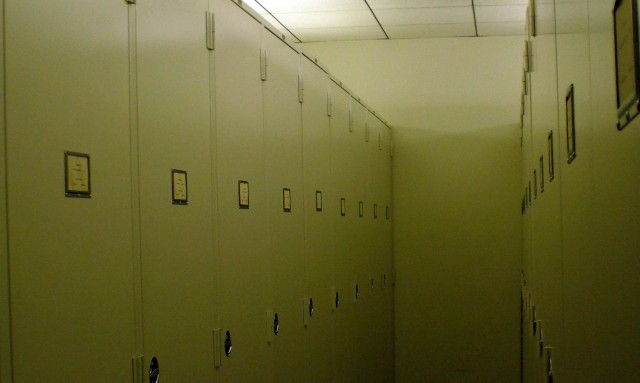A new use for 200-year-old pressed plants
Ecologists are looking to herbaria, the world’s historical libraries of preserved plants, to see how plants are reacting to global warming
Francie Diep • December 23, 2010
If you’ve ever pressed a local wildflower in the pages of the family dictionary, you’ve taken part in a long and venerable tradition. Generations of scientists and amateur wildlife enthusiasts have collected plants, fungi, and algae and mounted them onto sheets of paper to preserve them. Many of these sheets now serve as historical records in vast archives called herbaria. Some herbaria hold specimens gathered more than 200 years ago; most started with the personal collection of one dedicated person who amassed thousands of plants. Carl Linnaeus, the 18th-century botanist who created the scientific naming system of species we use today, collected 14,300 specimens that are still kept in The Linnean Society of London’s herbarium.
Now these old plants are getting pressed into the service of an entirely modern project. In the last decade, there has been growing interest in using herbaria to investigate the effects of climate change. Researchers want to use herbarium specimens to find out when plants flowered in the past, and to see if flowering times have changed in response to global warming. “Herbarium data is of great use in climate change studies,” said Nils Stenseth, an ecologist at the Center for Ecological and Evolutionary Synthesis in Oslo, Norway.
Drawing on herbarium data, Stenseth has shown that fungi in Norway and the U.K. are appearing 18 days earlier in the spring now than they did in 1960 and that this change correlates with the observed warming of winter. Other studies have found that warmer temperatures are associated with wildflowers blooming eight days earlier in Boston—and two to four weeks earlier in Quebec—than they did 100 years ago.
Shifts in flowering times are important because they have a ripple effect on all of the species that depend on a plant. For example, pollinating animals rely on regular springtime flowering to know when to arrive at a flower patch to drink nectar. Climate change could lead to a missed connection between plant and pollinator that’s detrimental to both. “Changes in flowering time can have big impacts on ecosystems,” said Abraham Miller-Rushing, the science coordinator for Acadia National Park in Maine. Miller-Rushing led the research on flowering times of plants in Boston’s Arnold Arboretum.
Cabinets holding specimens in the Brooklyn Botanic Garden’s herbarium. [Image Credit: Francie Diep]
How can pressed plants indicate climate change? When collectors take pressings for herbaria, they record when and where the plants were picked. Researchers then can see when a plant population blossomed in years past and compare historic blooming times with current blooming times. To determine if changes in blooming times correlate with changes in temperature, they look at meteorological records from the collection site.
Not everyone agrees this is a reliable way to measure plants’ response to climate change. “Some of my botanical and ecological colleagues see the effects of climate change on flora and vegetation everywhere they look,” said Eric Lamont, president of the Long Island Botanical Society in New York. “I’m just a little cautious.” Flowering times naturally vary, he said, so it’s hard to say if global warming is the culprit without data from more years than we have plant records for.
In addition, critics say the records that do exist can be hard to use. Herbarium researchers often cite a 2004 Trends in Ecology and Evolution paper that reports there are 2.5 billion plant and animal specimens in collections around the world. Most of these, however, can’t be used for climate studies, because older specimens collected by hobbyists may not come with exact dates, locations, or meteorological data, explained Thomas Zanoni, collections manager for the New York Botanical Garden’s herbarium in the Bronx.
A paper published in September should give this new method a boost. Anthony Davy, an ecologist at the University of East Anglia in Norwich, U.K., and his colleagues published research in the Journal of Ecology that verified the reliability of 150-year-old herbarium data by comparing them with modern field observations. Acadia National Park’s Miller-Rushing called the paper “a big deal.” He added, ”It’s a very well-done study to provide strong evidence that herbarium specimens can be used for this kind of research.”
When the pieces come together—the herbarium samples are old enough, frequent enough, and labeled enough, and there are accompanying meteorological records—the results are exciting for scientists. “This type of research is now increasingly popular. Ecologists are re-evaluating the value of biological collections,” said Claude Lavoie, an ecologist at Laval University in Quebec City. “Possibilities are almost unlimited.”
The possibilities can also be fun. The endless cabinets inside herbaria can seem intimidating and sterile, but they’re warmed by hints of the personalities of the dedicated collectors who established them, said Miller-Rushing. By looking through their pressings, “you kind of learn their habits. It’s kind of neat to get to know the people who were studying the same kinds of things 50 or 100 years ago through the specimens they collected.”

1 Comment
I disagree, read http://www.slate.com/articles/arts/gallery/2011/07/this-one-time-at-space-camp.html – Dominga